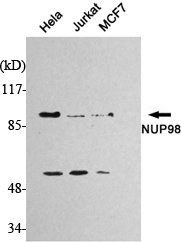Nup98 Monoclonal Antibody
- Catalog No.:YM1066
- Applications:WB
- Reactivity:Human;Mouse;Dog
- Target:
- Nup98
- Fields:
- >>Nucleocytoplasmic transport;>>Amyotrophic lateral sclerosis;>>Influenza A
- Gene Name:
- NUP98
- Protein Name:
- Nuclear pore complex protein Nup98-Nup96
- Human Gene Id:
- 4928
- Human Swiss Prot No:
- P52948
- Immunogen:
- Purified recombinant human Nup98 protein fragments expressed in E.coli.
- Specificity:
- Nup98 Monoclonal Antibody detects endogenous levels of Nup98 protein.
- Formulation:
- Liquid in PBS containing 50% glycerol, 0.5% BSA and 0.02% sodium azide.
- Source:
- Monoclonal, Mouse
- Dilution:
- WB 1:1000 - 1:2000. Not yet tested in other applications.
- Purification:
- Affinity purification
- Concentration:
- 1 mg/ml
- Storage Stability:
- -15°C to -25°C/1 year(Do not lower than -25°C)
- Other Name:
- NUP98;ADAR2;Nuclear pore complex protein Nup98-Nup96
- Molecular Weight(Da):
- 198kD
- Background:
- Nuclear pore complexes (NPCs) regulate the transport of macromolecules between the nucleus and cytoplasm, and are composed of many polypeptide subunits, many of which belong to the nucleoporin family. This gene belongs to the nucleoporin gene family and encodes a 186 kDa precursor protein that undergoes autoproteolytic cleavage to generate a 98 kDa nucleoporin and 96 kDa nucleoporin. The 98 kDa nucleoporin contains a Gly-Leu-Phe-Gly (GLGF) repeat domain and participates in many cellular processes, including nuclear import, nuclear export, mitotic progression, and regulation of gene expression. The 96 kDa nucleoporin is a scaffold component of the NPC. Proteolytic cleavage is important for targeting of the proteins to the NPC. Translocations between this gene and many other partner genes have been observed in different leukemias. Rearrangements typically result in chimeras with the N-terminal GLGF domain of
- Function:
- disease:A chromosomal aberration involving NUP98 is associated with pediatric acute myeloid leukemia (AML) with intermediate characteristics between M2-M3 French-American-British (FAB) subtypes. Translocation t(9;11)(p22;p15) with PSIP1/LEDGF. The chimeric transcript is an in-frame fusion of NUP98 exon 8 to PSIP1/LEDGF exon 4.,disease:A chromosomal aberration involving NUP98 is found in a form of acute myeloid leukemia. Translocation t(7;11)(p15;p15) with HOXA9. Translocation t(11;17)(p15;p13) with PHF23.,disease:A chromosomal aberration involving NUP98 is found in a form of T-cell acute lymphoblastic leukemia (T-ALL). Translocation t(3;11)(q12.2;p15.4) with LNP1.,disease:A chromosomal aberration involving NUP98 is found in a form of therapy-related myelodysplastic syndrome. Translocation t(11;20)(p15;q11) with TOP1.,disease:A chromosomal aberration involving NUP98 is found in childhood
- Subcellular Location:
- Nucleus membrane ; Peripheral membrane protein; Nucleoplasmic side . Nucleus, nuclear pore complex . Nucleus, nucleoplasm . Localized to the nucleoplasmic side of the nuclear pore complex (NPC), at or near the nucleoplasmic basket (PubMed:11839768). Dissociates from the dissasembled NPC structure early during prophase of mitosis (PubMed:12802065). Colocalized with NUP153 and TPR to the nuclear basket of NPC (PubMed:11839768). Colocalized with DHX9 in diffuse and discrete intranuclear foci (GLFG-body) (PubMed:11839768, PubMed:28221134). .; Nucleus membrane . (Microbial infection) Remains localized to the nuclear membrane after poliovirus (PV) infection. .
- Expression:
- Brain,Epithelium,Liver,Lung,Peripheral blood,Testis,
- June 19-2018
- WESTERN IMMUNOBLOTTING PROTOCOL
- June 19-2018
- IMMUNOHISTOCHEMISTRY-PARAFFIN PROTOCOL
- June 19-2018
- IMMUNOFLUORESCENCE PROTOCOL
- September 08-2020
- FLOW-CYTOMEYRT-PROTOCOL
- May 20-2022
- Cell-Based ELISA│解您多样本WB检测之困扰
- July 13-2018
- CELL-BASED-ELISA-PROTOCOL-FOR-ACETYL-PROTEIN
- July 13-2018
- CELL-BASED-ELISA-PROTOCOL-FOR-PHOSPHO-PROTEIN
- July 13-2018
- Antibody-FAQs
- Products Images

- Western Blot analysis using Nup98 Monoclonal Antibody against HeLa, Jurkat, MCF7 cell lysate.



